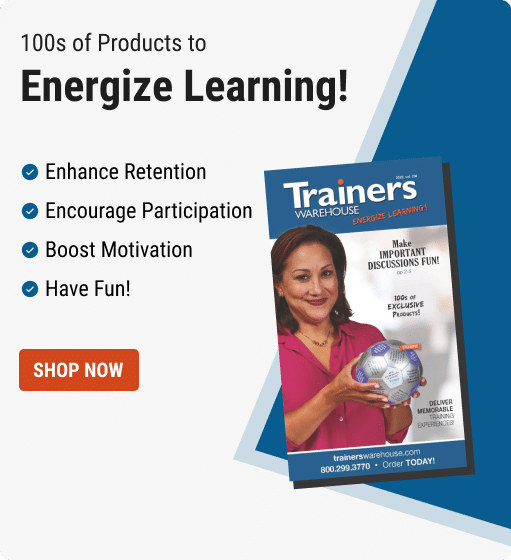The making and re-making of products
Last week, my 11-year-old had a week off from camp and said he wanted to come to work with me. I thought he’d help out in the Assembly Department, but he had Product Development in mind. Rather than explain that products take days, weeks, months, or even years to develop, I figured we could give it a try.
Coming up with the idea
We started off by thinking about what problem we wanted to solve. I interviewed him about what his teacher did well and what his student teacher didn’t do so well. We looked through catalogs of products for inspiration. In a relatively quick amount of time we realized that while Trainers Warehouse sells KUDOS pads that are perfect for adults at work, they’re not really suited for the educators. Henry went off by himself for a while so he could think of the types of messages he might like to hear from a teacher, such as “You took a risk,” “You stuck with the problem,” “You made a smart mistake,” etc. From there, he solicited feedback from teachers, friends, and people at work, made edits, and worked on the design until everyone was satisfied. In a few weeks, it will be ready to sell. He’s already asked about royalties!
Product engineering
I worry that Henry got the wrong impression. Normally, product development takes WAY longer than that. Take for instance our Dry-erase Name Tents, which have been around almost as long as our company. Although the basic idea hasn’t changed too much over the last 20 years, the execution has certainly evolved! The idea was a Name Card that didn’t require a “mail merge,” printing, folding and then throwing away. It could stand up and fold flat for storage. In their first iteration, the Name Tents were constructed of two separate pieces of dry-erase board, held together at the top with a flexible hinge. A VELCRO fastener at the back prevented them from falling flat, but allowed you to flatten them for storage.
- Paperclip the hinge (a.k.a. “stick”) – We’d take an 11-inch white plastic hinge and insert a paperclip to secure it in a closed position.
- Boil the sticks at home – My dad, who was an engineer before he was a business owner, knew that if we heated the plastics sticks in the flexed position, they would better hold their shape. So our employee, Olencia, brought the box of paper-clipped hinges to the house and boiled them in a big pot of water.
- Insert the cards into the hinges – after prepping the cards with a bit of hot glue, we’d insert the cards into the hinges
- Attach the VELCRO – For the tents to stay standing, we had to glue on foam pads to the inside of the cards, then attach VELCRO to the foam. This was what enabled the Up-Down function.
My dad was so proud of this invention that he’d stand in the aisle at Training trade shows, and in his PT Barnumesque way, beckon attendees to “come in and I’ll show you a trick!” He’d demonstrate the up-down movement and show off the excellent writing surface.
Product improvement
Over time, we discovered that the VELCRO fasteners simply weren’t holding up. We also felt that the product as a whole needed to look more professional. Our first change was to procure a special hinge that was not flexible but would hold its shape. Although this would prevent flat storage, it would eliminate the need for paper clips, boiling, foam pads and VELCRO. It still took a bit of hot glue, but they looked much better. After that success, we took it a step further and made them as a single molded piece. Our customers have continued to be pleased with each improvement.
Product extensions
Once you have a hit, the question is whether you can spin off more ideas from it. For the tents, this has meant the addition of our Space Saver Tent, Black Dry-Erase Tent (subsequently discontinued), which used fluorescent markers, Tent Card Quotes (pithy quotations you can stick on the cards that were also discontinued), and neon tents (yup, discontinued as well). In some ways, product extensions are a little easier than an original product idea because you’re building off something that’s tried and true. But, as history has proved, that doesn’t guarantee success! Maybe that’s why Henry was able to come up with a new product in just 2 weeks. My wish is that they all come that easily.

